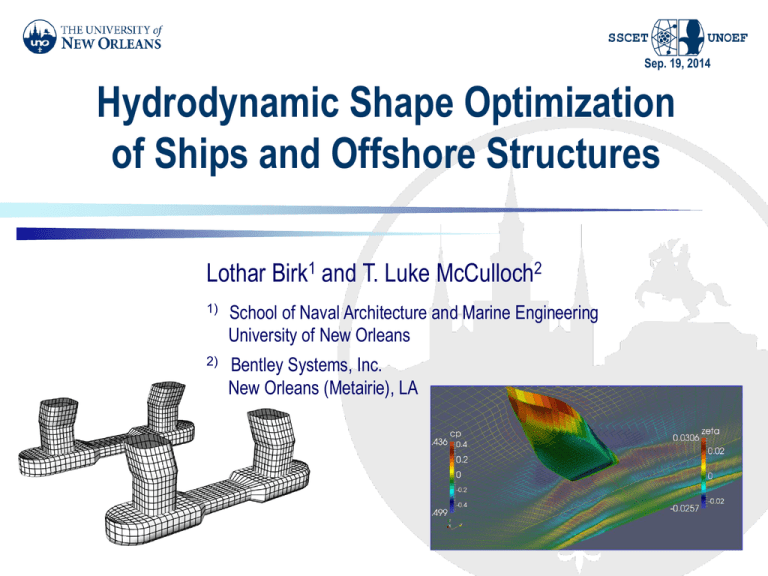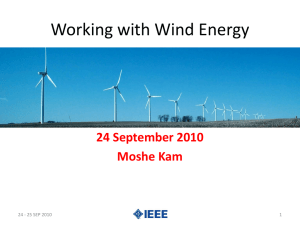Hydrodynamic shape optimization of ships and offshore - UNO-EF
advertisement

Sep. 19, 2014 Hydrodynamic Shape Optimization of Ships and Offshore Structures Lothar Birk1 and T. Luke McCulloch2 1) School of Naval Architecture and Marine Engineering University of New Orleans 2) Bentley Systems, Inc. New Orleans (Metairie), LA Overview Sep. 19, 2014 • Design optimization – Challenges and advantages • Automated shape optimization • Multi-objective optimization of a semisubmersible • Ongoing work on • Parametric design of ship hulls • Hydrodynamic analysis • Conclusions Design Challenges of Marine Industry • One-of-a-kind designs • limited design resources (time, money, engineers) • less automation in comparison to aircraft or car industry • no prototypes, less chance to correct design errors Sep. 19, 2014 Design Challenges – Knowledge Gap Sep. 19, 2014 • knowledge of detail marginally in early design phases L. Birk and T.L. McCulloch Design Challenges – Knowledge Gap Sep. 19, 2014 • knowledge of detail marginally in early design phases • however, financial impact of design decisions is huge L. Birk and T.L. McCulloch Design Challenges – Knowledge Gap • knowledge of detail marginally in early design phases • however, financial impact of design decisions is huge • knowledge gap has to be closed to improve designs Sep. 19, 2014 Closing the Knowledge Gap – How? Sep. 19, 2014 • Apply first principles based analysis as early as possible • requires more details of the design • provides base for rational decisions • Automate design processes • allows investigation of more design alternatives • enables application of formal optimization procedures Closing the Knowledge Gap – First Step …for the time being: Sep. 19, 2014 • Restriction to hull shape development • Integration of Computational Fluid Dynamic tools • Process control by optimization algorithms • New hull design philosophy Shape Optimization Needs Sep. 19, 2014 • Automated hull shape generation • non-interactive • driven by form parameters and parameter relations • Performance assessment • objective functions (stability, seakeeping, resistance, maneuvering …) • compare different designs • Constraints • ensure designs are feasible (technical, economical, …) • Optimization algorithm(s) • control of the optimization process • search algorithms, gradient based algorithms, genetic algorithms and evolutionary strategies, ... Automated Hull Generation – The Idea Traditional design Sep. 19, 2014 Shape optimization Parametric Model for Offshore Structures Sep. 19, 2014 Generation of Components Sep. 19, 2014 V,xc Cross section curve Frenet-Sweep operation Form parameters Cross section area curve Component NURBS surface 51,250t Semisubmersible Hull Sep. 19, 2014 51,250t Semisubmersible Hull Sep. 19, 2014 Merged Hull (only submerged part shown) 51,250t Semisubmersible Optimization • 8 free variables Sep. 19, 2014 51,250t Semisubmersible Optimization Sep. 19, 2014 • Two objectives • Minimize displacement / payload ratio • displacement is fixed, thus payload is maximized • payload assumed to be stored on deck • Minimize estimated average downtime • acceleration in work area is restricted • analysis performed considering wave scatter diagram including wind directions of target operating area • Constraints: • require sufficient initial stability at working and survival draft • several geometric restrictions North-East Atlantic (Marsden Square 182) Multi-Objective Optimization free variables define design space Sep. 19, 2014 objective function is vector valued design space further limited by constraints What constitutes the optimum? Multi-Objective Optimization • Pareto (1906) • Pareto frontier • designs that are at least in one objective better than all others • non-dominated solutions Sep. 19, 2014 Optimization Algorithm – ε-MOEA • ε-MOEA (Epsilon Multi-Objective Evolutionary Algorithm) K. Deb et al. (2001, 2003) • ε-dominance Sep. 19, 2014 Multi-Objective Hull Shape Optimization • Ideal solution f1 = 5.125 f2 = 0 • initial population contains 400 designs • a total of 2000 designs will be investigated Sep. 19, 2014 Estimated Pareto Frontier Sep. 19, 2014 Estimated Pareto Frontier Sep. 19, 2014 Estimated Pareto Frontier Sep. 19, 2014 Estimated Pareto Frontier Sep. 19, 2014 Ongoing Research at UNO Sep. 19, 2014 • Form parameter driven ship hull design • More complex than offshore structure hulls • More stringent fairness requirements • Hydrodynamics analysis • Wave resistance calculation • Integrate propeller selection / design • Goal of Research • • • • Hull definition description based on typical design coefficients Control of displacement distribution (impact on performance) Optimization of hull fairness / surface quality Robust hull generation Ship Hull Generation Process Sep. 19, 2014 • Shape generation via form parameter driven optimization (Harries) • Curves of form: SAC, design waterline, profile,… tangents, etc. • built from design specifications (form parameters) • curves of form control form parameters of station curves • Station curves: position • match curves of form at that station, e.g. SAC controls area of the station • local section control sectional area • Hull surface by lofting • Objective and Constraints design waterline AP • Curves are optimized for fairness • Constraints are the form parameters FP B-Spline Example • Start with basic curve • make a good guess (close to what you want) • this is non-linear optimization! Result depends on starting curve • Enforce desired constraints • We forced the end curvature to zero, • Many other constraints have been coded. • Automatic differentiation takes care of the derivative details. Sep. 19, 2014 B-Spline Design by Form Parameters Sep. 19, 2014 • Variational design, via Lagrangian Optimization F = the Lagrangian Functional f = the objective function(s) h = constraints λ = Lagrange multipliers • Necessary condition for optimum results in system of nonlinear equations • Solution using Newton-Iteration (gradient driven – takes lots of derivatives) • Implement automatic differentiation to make life easy (and isn’t that hard to do, conceptually) Automatic Differentiation • Object Oriented Implementation • Each variable stores value, gradient (1st order derivatives), and Hessian matrix (2nd order derivatives) • Overload (re-define) basic operators • Overload any needed analytic functions • Calculate the floating point value of any analytic expression • Calculate the gradient and Hessian of the expression, analytically, with floating point accuracy • Compute anything analytic! (No errors due to numerical differentiation) Sep. 19, 2014 Major Difficulties • Initial guesses • Harries (1998) exploited basic Bspline properties to define initial curve • Robustness / feasibility of solution • Hardest part of form parameter design • Inequality constraints, least squares objectives, and fuzzy logic have all been tried • Use the equations for initial estimate to guess feasible domains based on design choices • Research is ongoing! Sep. 19, 2014 starting curves are drawn for a range of form parameter tangent values Example: Hull with Well Defined Knuckle • Curves of form • sectional area curve (SAC) • design waterline, and • enforcing a corner condition • Created transverse curves to match the form curves at the station in question • Only final lofted hull is shown • Bulb is also based on form parameters (size exaggerated!) Sep. 19, 2014 Robust Performance Evaluation • Wave resistance • inviscid flow • panel method • nonlinear free surface condition • free trim and sinkage • useful for forebody optimization • Propeller design • lifting line • integrated into performance evaluation Sep. 19, 2014 Conclusions Sep. 19, 2014 • Integration of parametric design, hydrodynamic analysis and optimization algorithms enables design optimization • Design optimization can help to close the knowledge gap • Proven concept for offshore structures • Methods for robust, automated creation of design alternatives are a necessity The End Thank you for your attention ! Sep. 19, 2014 Sep. 19, 2014 Expected Downtime Computation x Sep. 19, 2014 = Short-term wave statistics representing a single design sea state RAOs (linear) computed with WAMIT (J.N. Newman, MIT) Long-term statistics of sea states Sep. 19, 2014 Occurrences of short-term sea states (Hs, T0) Wave scatter diagram Graphical representation of wave scatter diagram Assessment Based on Long Term Statistics Sep. 19, 2014 Estimation of downtime due to severe weather a) Specification of limit (2sa ) S ,limit 1.0m b) Assessment by short-term wave statistic for all zero-up-crossing period classes T0j: ( 2 sa ) S m0 S ( H S2 , T0 ) 4 f (T0 ) 2 HS HS (significant response amplitude operator) c) Expected downtime: Computation of maximum feasible significant wave height: 1 (2s ) H S ,limit (T0 ) (2sa ) S ,limit a S HS Account for all wind directions • Compute expected downtime for each wave direction • Build a weighted average Relative occurrence of wind direction qb Sep. 19, 2014 Comparison of Hydrodynamic Properties Sep. 19, 2014 Comparison of Hydrodynamic Properties Sep. 19, 2014 Comparison of Hydrodynamic Properties Sep. 19, 2014





